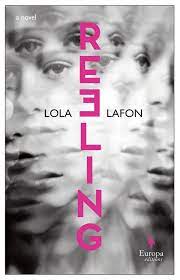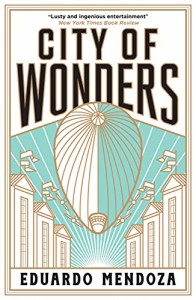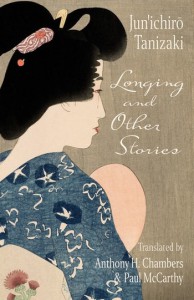Though this new year comes with its own shares of doubts and questions, what remains certain is that new titles and texts from around the world hold their own promises of enthrallment, knowledge, and beauty. This month, we present three works of fiction that traverse the realms of history, politics, and family. From a new collection of stories from Japanese master Jun’ichirō Tanizaki, to a novel interrogating the psychologies surrounding sexual predation by the award-winning Lola Lafon, to an imaginative journey into turn-of-the-century Barcelona with Eduardo Mendoza—these writings are sure to keep you thinking and dreaming.

Reeling by Lola Lafon, translated from the French by Hildegarde Serle, Europa Editions, 2022
Review by Barbara Halla, Assistant Editor
What we may reflexively call the “#MeToo era” has served as a cataclysm for the publication of several books of fiction and memoirs centered around women’s experiences with sexual violence. Far from being an Anglo-centric phenomenon, French works such as Vanessa Springora’s Consent (translated by Natasha Lehrer) and Camille Kouchner’s La Familia Grande (translated by Adriana Hunter) have garnered great acclaim for their unflinching and complicated portrayal of childhood sexual abuse. Lola Lafon’s Reeling, as well, lends itself easily to this movement, seeming particularly prescient considering the recent conviction of Ghislaine Maxwell for her role in the trafficking of underaged girls. The novel’s direct protagonists, Cléo and Betty, are two women whose lives are derailed by the Maxwell-like figure of Cathy—a stylish older woman who approaches young girls between thirteen and fourteen, offering them prestigious scholarships through the fictive Galatea foundation.
As Cathy prepares the girls for their “interviews,” she plies them with cares and attention, clothing and expensive perfumes; she makes them feel special, or rather that they are destined for something special. Yet, it is clear that something far more sinister hides behind the promises of scholarship. By the time the girls are to “interview” with the older male jurors, Cathy has earned their trust and affection; they would do anything to please her, to deserve her trust, to fulfill her expectations as she emphasizes the need for maturity and openness, the main criteria these “jurors” are looking for in the candidates.
Two important elements come to the fore in the figure of Cathy and her relationship to the young girls she grooms, and also in the encounters of girls like Cléo, Betty, and dozens of others with these older men. On the one hand, it is important to unpack the way Cathy manufactures consent through manipulation: although these girls do not want to do anything of a sexual nature during their “interviews,” many decide to go forward with it—not solely because of their own ambitions, but also to please a figure they have come to trust and revere. Secondly, the “jurors” themselves prey on the girls’ desire to appear mature, to show they are not “frigid” and thus somehow inadequate. This particular mind-game speaks also to the way sexual liberation—the result of the social and political movements that swept France during the 1960s and 1970s—often framed physical freedoms in ways that prioritized women’s and girls’ availability to men. As a thirteen-year-old Cléo thinks after her assault, “Cléo, thirteen years, five months, and however many days, had consented. To say no was to be frigid.”
In this framework, it becomes hard for the victims to speak up, because often they don’t even see themselves in these terms. When a duo of women journalists decides to gather material for a documentary on the Galatea foundation, one of the women they speak to asks herself: “I tried to tell my mother that something was wrong, but didn’t manage to. How could I have told her that, without being forced, I’d performed fellatio on an adult?”
The unacknowledged and pernicious ways in which “force” can manifest itself and the idea of perfect victimhood are central to Reeling. While the book follows the lives of Cléo and Betty, who both fell victims to these schemes, Lafon is also interested in the institutions and people that help perpetuate it: from families who write off someone like Betty as having “thrown her life” away at seventeen after “hooking up” with a much older man, to the way coercion is embedded sometimes even in the things we love. For instance, both Cléo and Betty are avid dancers who would do anything for their art. Later, when Cléo is in her late twenties and a dancer for a televised variety show, she confides about the abuse to her roommate Lara, who begins to think of how “all that made Cléo a sought-after dancer: her resilience to pain, her competitiveness, that capacity to execute exactly what she’d been asked” also made her more vulnerable to exploitation.
At the same time, Lafon herself is imminently aware of how writings on sexual violence can easily be incorporated into over-simplistic narratives, as when a TV presenter describes the documentary-makers—who are investigating the scholarship affair and the abuse that ensued—as “post-MeToo dispensers of justice and multi-award-winners at prestigious festivals.” In fact, Reeling critiques, even with the context of a social justice movement like #MeToo, the propensity to seek out perfect victims and explications for situations of abuse. As the dam breaks on the Galatea scholarship and its corruption, the first news story describes the victims as coming from: “Dysfunctional families. Broken up. Working class.” But none of these descriptions apply to Cléo, who came from a trusting and loving family, and who is now spending her life full of guilt and unable to figure out a way to absolve herself—even within the predominant narrative that is supposedly on the side of survivors.
Lafon has done a wonderful job of depicting the structures that enable sexual violence, and its traumatic aftermath on the victims: the shame, the disgust, and the need for forgiveness. And it seems to me important to highlight these aspects of the novel, but I am worried that I am doing so at the detriment of a more complex reading of the book, which is also a stunning portrayal of life in Paris and its outskirts throughout the 1980s and beyond—with all the social and political upheavals. There are vivid discussions of the art of dance, of falling in love with the right person at the wrong time, late-night conversations about working class rights and conditions, intergenerational clashes about feminism and objectification—all of which is no mere background to the larger story of sexual assault, rather a tapestry that allows the reader to appreciate the complex constellation that is one’s life because of trauma, while also searching beyond it.

City of Wonders by Eduardo Mendoza, translated from the Spanish by Nick Caistor, MacLehose Press, 2022
Review by Alan Mendoza Sosa, Editor-at-Large for Mexico
Halfway through Eduardo Mendoza’s City of Wonders, main character Onofre Bouvila buys a plot of land in a marginal neighborhood of Barcelona. He aims to sell it for a significantly higher price, even though it is “a medium-sized plot in an area that apparently offered no great attraction or possibility of development”; the only potential buyer offers him no more than the same amount he paid for it, to which Bouvila reacts with dissatisfaction. Lying with convincing determination, he assures the customer that the plot is worth far more than what he is offering—“four times its original value and the price is going up day by day.” After another bland offer, however, Bouvila decides to throw out his perplexed interlocutor. The man is left doubting himself, wondering whether Bouvila was right and whether the plot is as valuable as assured. His suspicions grow when he hears the rumor that a famous and profitable business will soon move closer to the plot, elevating the value of the neighborhood and the surrounding real estate. Blinded by his ambition, he eventually buys the land for Bouvila’s inflated price, finding out quickly that the profitable business had no such plan to move nearby, and that the plot, was in fact—as he had suspected from the beginning—worthless.
The vignette is only a minute piece of Mendoza’s wonderful picaresque, whose main plot line follows the social ascension of teenager tradesman and capo Onofre Bouvila in a similarly growing Barcelona, at the juncture between the nineteenth and twentieth centuries. Arriving from the countryside, Bouvila ascends rapidly—becoming not only richer, but also more powerful, cold-blooded, and vile, as the city itself also comes-of-age as a global industrial metropolis. The opening scene illustrates how Bouvila’s cunning and clever character drives, in part, his adopted home’s expedited development, but it also highlights an important theme in the novel—the power of stories to change and impact reality. In The White Album, American writer Joan Didion famously wrote that “we tell stories to ourselves in order to live,” underscoring the undervalued influence narratives hold in everyday life. Mendoza’s novel takes that proposition even further, showing how stories can permeate not only individual existences, but also the various relationships developed over a lifetime—between people, between citizens and states, between one and oneself. In City of Wonders, politicians wrestle with stories the world tells about Barcelona; a father risks his life so that his daughter does not hear his real story; Bouvila makes up stories to justify his crimes, telling them unapologetically to both others and himself. Every time a story is told or revealed, a state of affairs changes, quietly or dramatically, just as every time we hear the story of a character, a place, or a situation, the narrated world metamorphoses irrevocably.
Indeed, the form and structure of the novel embody such dramatic transformations. Mendoza is never shy of going into long digressions on the history—and tales—of Barcelona. Whenever a place is introduced, it is usually followed by an extended tangent about its past:
As with every other city, Barcelona periodically suffered from the most terrible plagues. In 1834, cholera carried off 3,521 people; twenty years later, the death toll was 5,640. In 1870 yellow fever brought from the Spanish Caribbean had spread throughout Barceloneta. The whole neighbourhood had been evacuated, and La Riba wharf burned down.
These asides are narrated in the factual, detached, and erudite tone of historical discourse—though they are to be taken with caution. As Mendoza himself points out in his introduction to the 2020 Spanish edition: “many have asked [him] whether the events that [he] presents in City of Wonders and the historical facts that he cites are true or imagined. The answer, of course, can only be one: the distinction is not important because everything, definitely, is only a novel” [my translation]. One has to suspend all belief and rejoice in the subtle presentation of each place—which will eventually become substantial elements of the plot; that is, the historical digressions are there to be enjoyed aesthetically, rather than judged intellectually. And just like with all the stories in the palette of this idiosyncratic portrait of Barcelona, the narrative changes irreversibly after one reads these historical portions, becoming more concrete, more grounded, more essential.
What sustains this impressive interweaving is, of course, language. I like to keep note of all the new words I encounter, both in English and Spanish; after reading about a quarter of City of Wonders, my word bank had grown by half of its original size (which was already considerable, for I have been building it non-stop since 2018). Mendoza’s rich vocabulary is used with laser precision. It contributes to the outlandish yet familiar—almost domestic—atmosphere of the novel. His sentences are also clear, precise, and robust. They slow down moments of suspense and accelerate time when the story asks for swifter steps—shared traits in both the original Spanish and its translation. It is not just splendid but also breathtaking how translator Nick Caistor captures Mendoza’s linguistic richness, transmitting the author’s vivid imagery with hypnotic skill, as in this arresting passage:
While the taxidermist was dealing with his father, Onofre wanted to see the dead monkey’s body one last time. The table it had been left on gave off a potent smell of formaldehyde. Lying on its back with its arms and legs drawn up, it looked smaller; a damp draught was stirring the poor animal’s grey whiskers. “Let’s go, Onofre,” his father said.
When juxtaposed with the source text in Spanish, the text in English is equally as seductive, engrossing, and electric—transposing the titular city into equal brilliance on the page.

Longing and Other Stories by Jun’ichirō Tanizaki, translated from Japanese by Anthony H. Chambers and Paul McCarthy, Columbia University Press, 2022
Review by Charlie Ng, Editor-at-Large for Hong Kong
Jun’ichirō Tanizaki’s works are known for their experimental quality and emphasis on aesthetics, and the three short stories collected in this book—all written in the first decade of Tanizaki’s career as a writer—are no exception. The titular story, “Longing,” has appeared in English in the past, but “Sorrows of a Heretic” and “The Story of an Unhappy Mother” are both Anglophone debuts; although the three stories have very diverse styles and moods, the plots all centre on family. While “Sorrows of a Heretic” represents a university student’s alienated yet deeply entwined relationship with his parents and sister, “Longing” and “The Story of an Unhappy Mother” foreground two emotionally laden mother-son relationships—a recurrent and crucial motif in Tanizaki’s fictional world.
It is not uncommon for critics to point out the influence of Tanizaki’s mother, O-Seki, considering the author’s preoccupation with the mother motif and his depiction of female figures in his stories. O-Seki’s background is very similar to that of Shōzaburō’s mother in “Sorrows of a Heretic”; both came from families of means, and, being treasured and spoiled, they similarly struggled to cope with reality and domestic duties when their married family’s fortune deteriorated. This is no coincidence, as Tanizaki has indicated in the story’s preface (not included in this translation) that it is his “one and only confessional work.” With its autobiographical dimension, “Sorrows of a Heretic” offers a glimpse of the writer’s youthful aspiration and aesthetic exploration of experimental narrative, which sharply departed from the dominant naturalist style of Japanese fiction in Tanizaki’s time. One cannot fail to notice the story’s Decadent aesthetics in its heretic protagonist Shōzaburō—a young man who, while priding himself on his artistic sensibility and immorality, is constantly indulging in self-pity because of his family’s poverty, to which he attributes his lack of achievement.
The narrative’s attention to the inner consciousness of Shōzaburō presents the immature mind of a young man and his morbid sensitivity. Tanizaki lets his reader scrutinize the weaknesses of Shōzaburō in a way that does not ask for sympathy, but nonetheless creates empathy precisely because of the human nature of such weaknesses. The Mamuro family, for Shōzaburō, is an origin he loathes but whose influences he cannot escape: “Though he despised his mother’s selfishness and his father’s lack of spirit, he couldn’t deny that he was their son and that he’d inherited their weaknesses.” Even Shōzaburō’s belief in his talent is possibly a conceit of self-image; when he hides himself in the library in an attempt to write, he finds it hard to concentrate and is eventually overwhelmed by dreamy, fantastical pleasures—indicating the lack of will power connecting him with his despised parents.
A turning point comes late in the story with the death of Shōzaburō’s younger sister, O-tomi, from consumption. Two months after the ill-fated incident, Shōzaburō is able to publish a short story, debuting in the literary scene. Although the relationship between the two incidents is open to interpretation, it perhaps suggests that art is born out of tragedy. The sibling relationship between Shōzaburō and his sister is far from loving, but the death of a young, beautiful girl comes to embody the fragile yet breathtaking beauty of life that stimulates Shōzaburō, who can finally translate the “serious side lay concealed in his heart of hearts” in the form of literary writing.
Women, beauty, and death are also present in “Longing,” but the ideas take a very different form. “Longing” evinces an eerily beautiful mood through the depiction of a young boy’s dreamy search for his mother, though it is later revealed that the journey is indeed a nostalgic dream of the real-life adult, longing for his dead parent. Threading through the short story and the child’s journey is the central image of the moon—quintessentially a symbol of femininity, with the added significance of maternity in this context. The white skin of a woman is closely associated with the moonlight shining on the ocean and the beach: “The nape of her neck—was it only a trick of the moonlight?—was amazingly white. It could never be that white if she were not a young woman . . . Only the nape of her neck and her wrist stood out, as pure white as the whitecaps gleaming in the sea’s offing”. Tanizaki’s description of a young female balladeer’s physical beauty combines the child’s Oedipal emotional attachment and the adult self’s sensual male desire, creating a delicate, enchanting, and receptive maternal image. Her beauty is heightened by her sadness, with tears rolling down her cheeks “like drops of dew overflowing from a lotus leaf”—which she attributes to the moon crying instead of herself. The moon as the archetypal feminine has transformed into this young woman, who fully embraces her maternity through her recognition of the young boy as her child; this wish-fulfilling moment of reunion elucidates that the plaintive dream is the culmination of a longing for the warm and receptive oceanic womb of his mother—forever lost to death, but immortalized in the depth of the unconscious and memory.
The family dynamic in “The Story of an Unhappy Mother” is depicted under a much more realistic light, but with a psychological depth comparable to that in the other two stories. The mother, Madame Tokioka, is a talkative, “somewhat vain,” but fragile and sensitive woman, to the degree of being occasionally melodramatic. Despite the loss of her husband at quite an early age, Madame Tokioka is happy to be surrounded by her filial children, though concerned with the marriage of her eldest son. The son, in a skillfully rendered manipulation, has satisfied his mother’s desire to choose his wife by first letting his girlfriend Fujiko, a young pianist, befriend his sister—inevitably bringing her to his mother’s attention. The happiness built up by this marriage, however, is drastically overturned by a dreadful boat capsizing, and the plot centralizes the age-old dilemma for men: if your mother and your wife were drowning, who would you save?
Tanizaki’s story dramatizes the situation with an unexpected twist; although all of the characters of the family are saved in one way or another, what really happens in the process makes up the core of this inquiry. His treatment does not attempt to resolve the moral dilemma, instead offering an intricate revelation of a mother’s psychology of dependence, as well as the conscience of a son inevitably affected by the deep influence of Confucian filial piety in Japanese culture. In line with the other two stories, “The Story of an Unhappy Mother” shows that life’s tragedy is unsparing, no matter what form it may take.
*****
Read more on the Asymptote blog:

